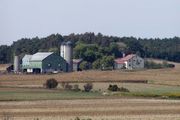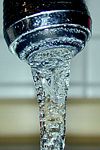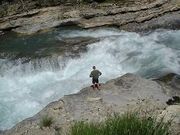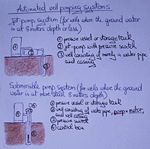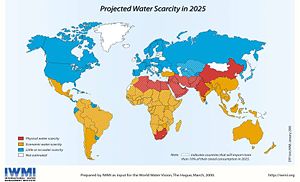Water resources
2008/9 Schools Wikipedia Selection. Related subjects: Geology and geophysics
Water resources are sources of water that are useful or potentially useful to humans. Uses of water include agricultural, industrial, household, recreational and environmental activities. Virtually all of these human uses require fresh water. 97.5% of water on the Earth is salt water, leaving only 2.5% as fresh water of which over two thirds is frozen in glaciers and polar ice caps. The remaining unfrozen freshwater is mainly found as groundwater, with only a small fraction present above ground or in the air. Fresh water is a renewable resource, yet the world's supply of clean, fresh water is steadily decreasing. Water demand already exceeds supply in many parts of the world, and as world population continues to rise at an unprecedented rate, many more areas are expected to experience this imbalance in the near future. The framework for allocating water resources to water users (where such a framework exists) is known as water rights.
Uses of fresh water
Uses of fresh water can be categorized as consumptive and non-consumptive (sometimes called "renewable"). A use of water is consumptive if that water is not immediately available for another use. Losses to sub-surface seepage and evaporation are considered consumptive, as is water incorporated into a product (such as farm produce). Water that can be treated and returned as surface water, such as sewage, is generally considered non-consumptive if that water can be put to additional use.
Agricultural
It is estimated that 69% of world-wide water use is for irrigation, with 15-35% of irrigation withdrawals being unsustainable .
In some areas of the world irrigation is necessary to grow any crop at all, in other areas it permits more profitable crops to be grown or enhances crop yield. Various irrigation methods involve different trade-offs between crop yield, water consumption and capital cost of equipment and structures. Irrigation methods such as most furrow and overhead sprinkler irrigation are usually less expensive but also less efficient, because much of the water evaporates or runs off. More efficient irrigation methods include drip or trickle irrigation, surge irrigation, and some types of sprinkler systems where the sprinklers are operated near ground level. These types of systems, while more expensive, can minimize runoff and evaporation. Any system that is improperly managed can be wasteful. Another trade-off that is often insufficiently considered is salinization of sub-surface water.
Aquaculture is a small but growing agricultural use of water. Freshwater commercial fisheries may also be considered as agricultural uses of water, but have generally been assigned a lower priority than irrigation (see Aral Sea and Pyramid Lake).
As global populations grow, and as demand for food increases in a world with a fixed water supply, there are efforts underway to learn how to produce more food with less water, through improvements in irrigation methods and technologies, agricultural water management, crop types, and water monitoring.
Industrial
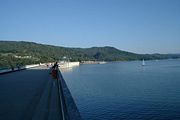
It is estimated that 15% of world-wide water use is industrial. Major industrial users include power plants, which use water for cooling or as a power source (i.e. hydroelectric plants), ore and oil refineries, which use water in chemical processes, and manufacturing plants, which use water as a solvent.
The portion of industrial water usage that is consumptive varies widely, but as a whole is lower than agricultural use.
Household
It is estimated that 15% of world-wide water use is for household purposes. These include drinking water, bathing, cooking, sanitation, and gardening. Basic household water requirements have been estimated by Peter Gleick at around 50 liters per person per day, excluding water for gardens.
Recreation
Recreational water use is usually a very small but growing percentage of total water use. Recreational water use is mostly tied to reservoirs. If a reservoir is kept fuller than it would otherwise be for recreation, then the water retained could be categorized as recreational usage. Release of water from a few reservoirs is also timed to enhance whitewater boating, which also could be considered a recreational usage. Other examples are anglers, water skiers, nature enthusiasts and swimmers.
Recreational usage is usually non-consumptive. Golf courses are often targeted as using excessive amounts of water, especially in drier regions. It is, however, unclear whether recreational irrigation (which would include private gardens) has a noticeable effect on water resources. This is largely due to the unavailability of reliable data. Some governments, including the Californian Government, have labelled golf course usage as agricultural in order to deflect environmentalists' charges of wasting water. However, using the above figures as a basis, the actual statistical effect of this reassignment is close to zero.
Additionally, recreational usage may reduce the availability of water for other users at specific times and places. For example, water retained in a reservoir to allow boating in the late summer is not available to farmers during the spring planting season. Water released for whitewater rafting may not be available for hydroelectric generation during the time of peak electrical demand.
Environmental
Explicit environmental water use is also a very small but growing percentage of total water use. Environmental water usage includes artificial wetlands, artificial lakes intended to create wildlife habitat, fish ladders around dams, and water releases from reservoirs timed to help fish spawn.
Like recreational usage, environmental usage is non-consumptive but may reduce the availability of water for other users at specific times and places. For example, water release from a reservoir to help fish spawn may not be available to farms upstream.
Water stress
The concept of water stress is relatively simple: According to the World Business Council for Sustainable Development, it applies to situations where there is not enough water for all uses, whether agricultural, industrial or domestic. Defining thresholds for stress in terms of available water per capita is more complex, however, entailing assumptions about water use and its efficiency. Nevertheless, it has been proposed that when annual per capita renewable freshwater availability is less than 1,700 cubic meters, countries begin to experience periodic or regular water stress. Below 1,000 cubic meters, water scarcity begins to hamper economic development and human health and well-being.
Population growth
In 2000, the world population was 6.2 billion. The UN estimates that by 2050 there will be an additional 3 billion people with most of the growth in developing countries that already suffer water stress. Thus, water demand will increase unless there are corresponding increases in water conservation and recycling of this vital resource.
Increased affluence
The rate of poverty alleviation is increasing especially within the two population giants of China and India. However, increasing affluence inevitably means more water consumption: from needing clean fresh water 24 hours a day, 7 days a week and basic sanitation service, to demanding water for gardens and car washing, to wanting jacuzzis or private swimming pools.
Expansion of business activity
Business activity ranging from industrialization to services such as tourism and entertainment continues to expand rapidly. This expansion requires increased water services including both supply and sanitation, which can lead to more pressure on water resources and natural ecosystems.
Rapid urbanization
The trend towards urbanization is accelerating. Small private wells and septic tanks that work well in low-density communities are not feasible within high-density urban areas. Urbanization requires significant investment in water infrastructure in order to deliver water to individuals and to process the concentrations of wastewater – both from individuals and from business. These polluted and contaminated waters must be treated or they pose unacceptable public health risks. In 60% of European cities with more than 100,000 people, groundwater is being used at a faster rate than it can be replenished. Even if some water remains available, it costs more and more to capture it.
Climate change
Climate change could have significant impacts on water resources around the world because of the close connections between the climate and hydrologic cycle. Rising temperatures will increase evaporation and lead to increases in precipitation, though there will be regional variations in rainfall. Overall, the global supply of freshwater will increase. Both droughts and floods may become more frequent in different regions at different times, and dramatic changes in snowfall and snowmelt are expected in mountainous areas. Higher temperatures will also affect water quality in ways that are not well understood. Possible impacts include increased eutrophication. Climate change could also mean an increase in demand for farm irrigation, garden sprinklers, and perhaps even swimming pools.
Depletion of aquifers
Due to the expanding human population, competition for water is growing such that many of the worlds major aquifers are becoming depleted. This is due both for direct human consumption as well as agricultural irrigation by groundwater. Millions of pumps of all sizes are currently extracting groundwater throughout the world. Irrigation in dry areas such as northern China and India is supplied by groundwater, and is being extracted at an unsustainable rate. Cities that have experienced aquifer drops between 10 to 50 meters include Mexico City, Bangkok, Manila, Beijing, Madras and Shanghai.
Pollution and water protection
Water pollution is one of the main concerns of the world today. The governments of many countries have striven to find solutions to reduce this problem. Many pollutants threaten water supplies, but the most widespread, especially in underdeveloped countries, is the discharge of raw sewage into natural waters; this method of sewage disposal is the most common method in underdeveloped countries, but also is prevalent in quasi-developed countries such as China, India and Iran.
Sewage, sludge, garbage, and even toxic pollutants are all dumped into the water. Even if sewage is treated, problems still arise. Treated sewage forms sludge, which is sent out into the sea and dumped. In addition to sewage, chemicals dumped by industries and governments are another major source of water pollution.
Water and conflict
The only known example of an actual inter-state conflict over water took place between 2500 and 2350 BC between the Sumerian states of Lagash and Umma. Yet, despite the lack of evidence of international wars being fought over water alone, water has been the source of various conflicts throughout history. When water scarcity causes political tensions to arise, this is referred to as water stress. Water stress has led most often to conflicts at local and regional levels. Using a purely quantitative methodology, Thomas Homer-Dixon successfully correlated water scarcity and scarcity of available arable lands to an increased chance of violent conflict.
Water stress can also exacerbate conflicts and political tensions which are not directly caused by water. Gradual reductions over time in the quality and/or quantity of fresh water can add to the instability of a region by depleting the health of a population, obstructing economic development, and exacerbating larger conflicts.
Conflicts and tensions over water are most likely to arise within national borders, in the downstream areas of distressed river basins. Areas such as the lower regions of China's Yellow River or the Chao Phraya River in Thailand, for example, have already been experiencing water stress for several years. Additionally, certain arid countries which rely heavily on water for irrigation, such as China, India, Iran, and Pakistan, are particularly at risk of water-related conflicts.. Political tensions, civil protest, and violence may also occur in reaction to water privatization. The Bolivian Water Wars of 2000 are a case in point.3. We use water in a lot of different ways. We use water for recreation such as swimming. We use water to wash objects. Water is used for electricity and irrigation. It is used to water plants; sprinklers also use water. Water is used for farming and growing crops.
World water supply and distribution
Food and water are two basic human needs. However, global coverage figures from 2002 indicate that, of every 10 people:
- roughly 5 have a connection to a piped water supply at home (in their dwelling, plot or yard);
- 3 make use of some other sort of improved water supply, such as a protected well or public standpipe;
- 2 are unserved;
- In addition, 4 out of every 10 people live without improved sanitation.
At Earth Summit 2002 governments approved a Plan of Action to:
- Halve by 2015 the proportion of people unable to reach or afford safe drinking water. The Global Water Supply and Sanitation Assessment 2000 Report (GWSSAR) defines "Reasonable access" to water as at least 20 liters per person per day from a source within one kilometer of the user’s home.
- Halve the proportion of people without access to basic sanitation. The GWSSR defines "Basic sanitation" as private or shared but not public disposal systems that separate waste from human contact.
As the picture shows, in 2025, water shortages will be more prevalent among poorer countries where resources are limited and population growth is rapid, such as the Middle East, Africa, and parts of Asia. By 2025, large urban and peri-urban areas will require new infrastructure to provide safe water and adequate sanitation. This suggests growing conflicts with agricultural water users, who currently consume the majority of the water used by humans.
Generally speaking the more developed countries of North America, Europe and Russia will not see a serious threat to water supply by the year 2025, not only because of their relative wealth, but more importantly their populations will be better aligned with available water resources. North Africa, the Middle East, South Africa and northern China will face very severe water shortages due to physical scarcity and a condition of overpopulation relative to their carrying capacity with respect to water supply. Most of South America, Sub-Saharan Africa, Southern China and India will face water supply shortages by 2025; for these latter regions the causes of scarcity will be economic constraints to developing safe drinking water, as well as excessive population growth.
Economic considerations
Water supply and sanitation require a huge amount of capital investment in infrastructure such as pipe networks, pumping stations and water treatment works. It is estimated that Organisation for Economic Co-operation and Development (OECD) nations need to invest at least USD 200 billion per year to replace aging water infrastructure to guarantee supply, reduce leakage rates and protect water quality.
International attention has focused upon the needs of the developing countries. To meet the Millennium Development Goals targets of halving the proportion of the population lacking access to safe drinking water and basic sanitation by 2015, current annual investment on the order of USD 10 to USD 15 billion would need to be roughly doubled. This does not include investments required for the maintenance of existing infrastructure.
Once infrastructure is in place, operating water supply and sanitation systems entails significant ongoing costs to cover personnel, energy, chemicals, maintenance and other expenses. The sources of money to meet these capital and operational costs are essentially either user fees, public funds or some combination of the two.
But this is where the economics of water management start to become extremely complex as they intersect with social and broader economic policy. Such policy questions are beyond the scope of this article, which has concentrated on basic information about water availability and water use. They are, nevertheless, highly relevant to understanding how critical water issues will affect business and industry in terms of both risks and opportunities.
Business response
The World Business Council for Sustainable Development in its H2OScenarios engaged in a scenario building process to:
- Clarify and enhance understanding by business of the key issues and drivers of change related to water.
- Promote mutual understanding between the business community and non-business stakeholders on water management issues.
- Support effective business action as part of the solution to sustainable water management.
It concluded that
- Business cannot survive in a society that thirsts
- You don’t have to be in the water business to have a water crisis.
- Business is part of the solution, and its potential is driven by its engagement.
- Growing water issues and complexity will drive up costs.
